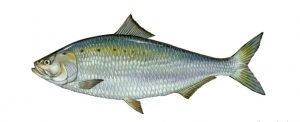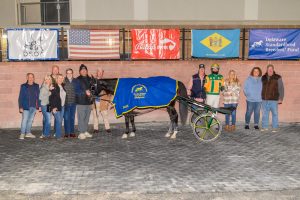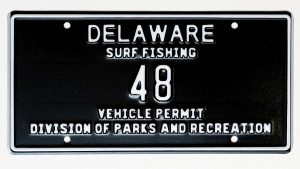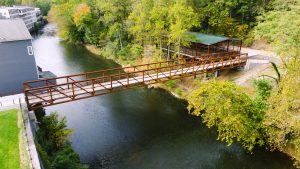DAGSBORO (May 22, 2013) – Delaware’s first foray into beneficial-reuse marsh restoration recently twinned maintenance dredging and “thin-layer” spray application of dredge spoil material as a one-two punch for reinvigorating a faltering marsh on Pepper Creek in Dagsboro. The project – a collaborative effort with the Center for Inland Bays, spearheaded by DNREC’s Division of Watershed Stewardship and entailing many other department programs – involved extensive planning, environmental permitting and the customizing of equipment for the innovative dredging and thin-layer application.
The project – a collaborative effort with the Center for Inland Bays, spearheaded by DNREC’s Division of Watershed Stewardship and entailing many other department programs – involved extensive planning, environmental permitting and the customizing of equipment for the innovative dredging and thin-layer application.
The opportunity was ripe for a thin-layer beneficial-reuse restoration project at the 47-acre site within a state wildlife area on Piney Point in Sussex County. Upland dredge spoil disposal sites used in the past are filling up, and also can be costly to lease and maintain. The alternative of applying dredge material back onto tidal wetlands supplies wetlands with extra sediment that helps maintain surface elevations above rising sea levels. Wetlands also use the nutrients in the supplemental material to increase plant cover and surface stability. 
Thin-layer disposal has been successfully deployed along the Gulf Coast for tidal marsh restoration to treat deteriorating areas, but never before in Delaware. At Pepper Creek, thin-layer dredge disposal applied sediment in the form of silt slurry to the marsh surface by pumping dredge material through a specially-constructed pipeline and spray-nozzle system. Specialized equipment for the project – to transport the dredged material from the main barge in the navigation channel to the shoreline – included flexible piping and a pivoting nozzle mounted on a mini-barge that can be moved along the marsh edge and up channels to extend the reach of sprayed material.
DNREC Secretary Collin O’Mara noted that the thin-layer project at Pepper Creek marsh simultaneously fulfilled multiple objectives for the state and was a model for environmental cooperation. “By working together across the agency and with the Center for the Inland Bays, the Pepper Creek project achieved department goals, at the same time improving boating safety, preserving wildlife habitat, restoring critical wetlands and improving water quality,” he said. “Adopting this innovative approach will significantly improve the environmental outcome for the marsh and other restoration sites, at a fraction of the cost of the traditional way of doing business.”
DNREC had disparate goals at the marsh restoration site, all of which complemented thin-layer beneficial-reuse application. The Shoreline & Waterway Management Section needed to explore alternatives for disposing of material from maintenance dredging. The Watershed Assessment Section has long been interested in the potential of thin-layer application for improving coastal wetlands. DNREC’s Division of Fish & Wildlife has a vested interest in preparing its wildlife areas for sea level rise by way of maintaining important coastal habitat. The Division of Water’s Wetlands and Subaqueous Lands Section was keen on researching the dredge and spray technique to support their permit reviews. Meanwhile, DNREC’s Delaware Coastal Programs lent support during planning and permitting phases, while the Center for Inland Bays was a major partner throughout the project. The CIB also supplied funding for a portion of the pipeline needed on Pepper Creek and continues to monitor aspects of it while helping with planning for future projects using the thin-layer technique.
“This thin-layer project delivered ecological benefits through a collaborative process,” said Frank Piorko, director, DNREC Division of Watershed Stewardship. “Our wetlands science team provided funding and program direction for a shoreline assessment performed by the Center for the Inland Bays. DNREC’s Shoreline & Waterway Management staff provided technical and operations expertise and support to modify equipment, explore a new beneficial use of sediment as a demonstration effort, and the entire team now looks forward to monitoring this location and moving forward in a new direction for waterway management.”
DNREC’s research crew originally selected the thin-layer spray disposal site along Pepper Creek because it is adjacent to the dredging project and was deemed in need of restoration. Highly-sensitive equipment for measuring surface elevation found it to have lower elevation than other tidal wetlands in the Inland Bays, and therefore more vulnerable to rising sea levels. If tidal wetlands cannot accrue or accrete sediment quickly enough to keep pace with water levels, a marsh will eventually convert to open water. Coastal wetlands can also migrate inland slowly if the shoreline is unobstructed by manmade materials.
The silt slurry was sprayed on the marsh at approximately 3,000 gallons per minute. The slurry was composed of approximately 85-90 percent water with sediment particles suspended in the water. Part of the planning effort involved anticipating potential runoff and reduced water clarity. As a precaution, the team also installed sediment traps in the major wetland guts and ditches using hay bales and straw logs secured with wooden stakes. The traps allowed water to flow past during the tide cycles and did not cutoff fish passage, but caught and held sediment particles until they could settle out of the water column. Work on the project also adhered to state and federal permit conditions that called for avoiding negative impacts to fisheries and marsh dwelling species.
DNREC applied up to 6 inches of sediment to the large emergent wetland. With each tide cycle, the applied material dispersed across the marsh surface, leaving an even layer that will settle over the next few months. The areas of marsh where the work was conducted were monitored daily and found to be accreting uniformly at acceptable levels.
Small areas where grasses were knocked down by force of the sprayer will be replanted in time for the summer growing season. Site monitoring for detailed indicators such as plant cover, surface elevation and below-ground root volume will continue for two years. Results gathered from the Pepper Creek project will be used to support similar projects in the future.
Contact: Michael Globetti, DNREC Public Affairs, 302-739-9902
Vol. 43, No. 212
-30-






































































 The project – a collaborative effort with the Center for Inland Bays, spearheaded by DNREC’s Division of Watershed Stewardship and entailing many other department programs – involved extensive planning, environmental permitting and the customizing of equipment for the innovative dredging and thin-layer application.
The project – a collaborative effort with the Center for Inland Bays, spearheaded by DNREC’s Division of Watershed Stewardship and entailing many other department programs – involved extensive planning, environmental permitting and the customizing of equipment for the innovative dredging and thin-layer application. 


